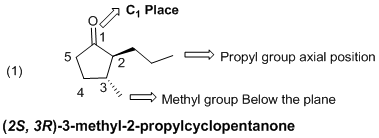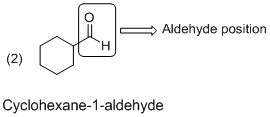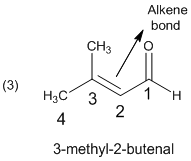
(a)
Interpretation:
The systematic (IUPAC) name of each group substituent in the given organic molecules should be draw and identified.
Concept introduction:
The several organic compounds can be named by using certain rules given by IUPAC (International Union for Pure and applied chemistry).
The IUPAC name consists of three parts in major namely Prefix, suffix and root word.
Prefix: Represents the substituent present in the molecule and its position in the root name.
For example the saturated hydrocarbons not only from only carbon-hydrogen bonds rather than the carbon-carbon bonds that have added hydrogen atoms. These
Suffix: Denotes the presence of
Root word: It represents the longest continuous carbon skeleton of the organic molecule.
To identify: The systematic (stereo chemical) name for the given molecule (a).
(a)
Explanation of Solution
Explanation

The given molecule (a) is drawn as above, in the case the carbonyl group is part of carbonyl group of a five membered ring, so the given molecule is cyclopentane-1-one. In the given molecule the parent carbon skeleton is cyclic in nature which contains of 5 carbons one keto group (-C=O). Hence root name of the molecule is ‘cyclopentane-1-one’. Since it is an alkane with five carbons, one keto then ‘1-pentanone’ will be the functional carbon chain name.
Further the molecule (a) one cyclic
Hence the systematic name for the molecule (a) is (2S, 3R)-3-methyl-2-propylcyclopentanone.
(b)
Interpretation:
The systematic (IUPAC) name of each group substituent in the given organic molecules should be draw and identified.
Concept introduction:
The several organic compounds can be named by using certain rules given by IUPAC (International Union for Pure and applied chemistry).
The IUPAC name consists of three parts in major namely Prefix, suffix and root word.
Prefix: Represents the substituent present in the molecule and its position in the root name.
For example the saturated hydrocarbons not only from only carbon-hydrogen bonds rather than the carbon-carbon bonds that have added hydrogen atoms. These alkanes have to prefix ‘cyclo’ due to the configuration of rings of carbon atoms.
Suffix: Denotes the presence of functional group if any in the molecule. It can be an alkane, alkene, alkyne, alcohol, carboxylic acid, alcohol etc. For example alkene molecules, suffix will be ‘ene’. (Or) If the presence of completely saturated alkane molecules, suffix will be ‘ane’.
Root word: It represents the longest continuous carbon skeleton of the organic molecule.
To identify: The systematic (stereo chemical) name for the given molecule (a).
(b)
Explanation of Solution
Explanation

The given molecule (b) is drawn; the parent carbon skeleton is cyclic nature which contains 6 carbons one keto group. Hence root name of the molecule is cyclohexane-1-carbaldehyde. Here given compound with six carbon atoms, one keto groups then cyclohexane
The cyclic compound containing a one aldehyde (
Hence the systematic name for the molecule (b) is ‘Cyclohexane-1-aldehyde’ (aldehyde group is connected to a six membered ring at C1 place).
(c)
Interpretation:
The systematic (IUPAC) name of each group substituent in the given organic molecules should be draw and identified.
Concept introduction:
The several organic compounds can be named by using certain rules given by IUPAC (International Union for Pure and applied chemistry).
The IUPAC name consists of three parts in major namely Prefix, suffix and root word.
Prefix: Represents the substituent present in the molecule and its position in the root name.
For example the saturated hydrocarbons not only from only carbon-hydrogen bonds rather than the carbon-carbon bonds that have added hydrogen atoms. These alkanes have to prefix ‘cyclo’ due to the configuration of rings of carbon atoms.
Suffix: Denotes the presence of functional group if any in the molecule. It can be an alkane, alkene, alkyne, alcohol, carboxylic acid, alcohol etc. For example alkene molecules, suffix will be ‘ene’. (Or) If the presence of completely saturated alkane molecules, suffix will be ‘ane’.
Root word: It represents the longest continuous carbon skeleton of the organic molecule.
To identify: The systematic (stereo chemical) name for the given molecule (a).
(c)
Explanation of Solution
Explanation

The given molecule is drawn as shown above. This compound (c) is an one aldehyde group with a parent of four carbon, so the parent should be butanol. In the given molecule the parent carbon skeleton is contains 4 carbons one double bond, which indicated by changing ‘an’ to ‘en’ as in propane into propene.
In molecule (c) parent (or) functional group is numbered so that the
Hence the systematic name for the molecule (c) is 3-methyl-2-butenal.
(d)
Interpretation:
The systematic (IUPAC) name of each group substituent in the given organic molecules should be draw and identified.
Concept introduction:
The several organic compounds can be named by using certain rules given by IUPAC (International Union for Pure and applied chemistry).
The IUPAC name consists of three parts in major namely Prefix, suffix and root word.
Prefix: Represents the substituent present in the molecule and its position in the root name.
For example the saturated hydrocarbons not only from only carbon-hydrogen bonds rather than the carbon-carbon bonds that have added hydrogen atoms. These alkanes have to prefix ‘cyclo’ due to the configuration of rings of carbon atoms.
Suffix: Denotes the presence of functional group if any in the molecule. It can be an alkane, alkene, alkyne, alcohol, carboxylic acid, alcohol etc. For example alkene molecules, suffix will be ‘ene’. (Or) If the presence of completely saturated alkane molecules, suffix will be ‘ane’.
Root word: It represents the longest continuous carbon skeleton of the organic molecule.
To identify: The systematic (stereo chemical) name for the given molecule (a).
(d)
Explanation of Solution
Explanation

The given linear molecule is drawn as shown above. The parent is a chain of six carbon atoms, with the carbonyl group at C3, so the parent is 3-hexanone. Further the identified number of substituents, above the compound is only one methyl group at C4 position.
Hence the assign a configuration to the chirality center for the molecule (d) is (S)-4-methyl-3-hexanone.
Want to see more full solutions like this?
Chapter 20 Solutions
Organic Chemistry, Binder Ready Version
- > For each pair of substrates below, choose the one that will react faster in a substitution reaction, assuming that: 1. the rate of substitution doesn't depend on nucleophile concentration and 2. the products are a roughly 50/50 mixture of enantiomers. Substrate A Substrate B Faster Rate X CI (Choose one) (Choose one) CI Br Explanation Check Br (Choose one) C 2025 McGraw Hill LLC. All Rights Reserved. Terms of Use | Privacy A F10arrow_forwardHow to draw this mechanism for the foloowing reaction in the foto. thank youarrow_forwardPredict the major products of the following organic reaction: Some important notes: CN A? • Draw the major product, or products, of the reaction in the drawing area below. • If there aren't any products, because no reaction will take place, check the box below the drawing area instead. • Be sure to use wedge and dash bonds when necessary, for example to distinguish between major products that are enantiomers. No reaction. Explanation Check Click and drag to start drawing a structure. 2025 McGraw Hill LLC. All Rights Reserved. Terms of Use Privacy Centerarrow_forward
- Draw the major product of the following reaction. Do not draw inorganic byproducts. H3PO4 OHarrow_forwardPredict the major products of this organic reaction: HBr (1 equiv) Δ ? Some important notes: • Draw the major product, or products, of this reaction in the drawing area below. • You can draw the products in any arrangement you like. • Pay careful attention to the reaction conditions, and only include the major products. • Be sure to use wedge and dash bonds when necessary, for example to distinguish between major products that are enantiomers. • Note that there is only 1 equivalent of HBr reactant, so you need not consider the case of multiple additions. Explanation Check X ©2025 McGraw Hill LLC. All Rights Reserved. Terms of Use | Privacyarrow_forwardFor the structure below, draw the resonance structure that is indicated by the curved arrow(s). Be sure to include formal charges. :ÖH Modify the second structure given to draw the new resonance structure. Include lone pairs and charges in your structure. Use the + and - tools to add/remove charges to an atom, and use the single bond tool to add/remove double bonds.arrow_forward
- Using the table of Reactants and Products provided in the Hints section, provide the major product (with the correct stereochemistry when applicable) for questions below by selecting the letter that corresponds to the exact chemical structures for the possible product. OH conc Hydrochloric acid 40°C Temp A/arrow_forwardUsing arrows to designate the flow of electrons, complete the reaction below and provide a detailed mechanism for the formation of the product OH conc Hydrochloric acid 40°C Temp All chemical structures should be hand drawn on a piece of paper Paragraph BI UAE +varrow_forwarddraw out the following structures plesearrow_forward
- Draw everything on a piece of paper outlining the synthesis from acetaldehyde to 2 cyclopentene carboxaldehyde using carbon based reagants with 3 carbons or fewers. Here is the attached image.arrow_forwardManoharan Mariappan, FR.D., 34) Complete the following reaction starting from hex-1-yne proceeding via different substitution reactions forming 2-heptanone. (25 pts). A Sia₂BH H₂O₂ NaOH Br D Mechanism for reaction D - ether-cleavage: 10 B Ph-MgCI, THF H₁₂O+ D HBr (XS) C TsCl, Py CH3-CH2-CH2-ONaarrow_forwardIn the table below, the correct structure for (2R)-3-methylpentan-2-ol (IUPAC name) can be represented by the letter OH OH HE > ' ÕH C B OH D A/ E OHarrow_forward
 ChemistryChemistryISBN:9781305957404Author:Steven S. Zumdahl, Susan A. Zumdahl, Donald J. DeCostePublisher:Cengage Learning
ChemistryChemistryISBN:9781305957404Author:Steven S. Zumdahl, Susan A. Zumdahl, Donald J. DeCostePublisher:Cengage Learning ChemistryChemistryISBN:9781259911156Author:Raymond Chang Dr., Jason Overby ProfessorPublisher:McGraw-Hill Education
ChemistryChemistryISBN:9781259911156Author:Raymond Chang Dr., Jason Overby ProfessorPublisher:McGraw-Hill Education Principles of Instrumental AnalysisChemistryISBN:9781305577213Author:Douglas A. Skoog, F. James Holler, Stanley R. CrouchPublisher:Cengage Learning
Principles of Instrumental AnalysisChemistryISBN:9781305577213Author:Douglas A. Skoog, F. James Holler, Stanley R. CrouchPublisher:Cengage Learning Organic ChemistryChemistryISBN:9780078021558Author:Janice Gorzynski Smith Dr.Publisher:McGraw-Hill Education
Organic ChemistryChemistryISBN:9780078021558Author:Janice Gorzynski Smith Dr.Publisher:McGraw-Hill Education Chemistry: Principles and ReactionsChemistryISBN:9781305079373Author:William L. Masterton, Cecile N. HurleyPublisher:Cengage Learning
Chemistry: Principles and ReactionsChemistryISBN:9781305079373Author:William L. Masterton, Cecile N. HurleyPublisher:Cengage Learning Elementary Principles of Chemical Processes, Bind...ChemistryISBN:9781118431221Author:Richard M. Felder, Ronald W. Rousseau, Lisa G. BullardPublisher:WILEY
Elementary Principles of Chemical Processes, Bind...ChemistryISBN:9781118431221Author:Richard M. Felder, Ronald W. Rousseau, Lisa G. BullardPublisher:WILEY





